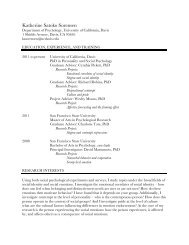SMART Board User's Guide - Psychology
SMART Board User's Guide - Psychology
SMART Board User's Guide - Psychology
You also want an ePaper? Increase the reach of your titles
YUMPU automatically turns print PDFs into web optimized ePapers that Google loves.
Using an Interactive Whiteboard with a<br />
Projector<br />
When you use a projector with your interactive whiteboard, finger contact on the <strong>SMART</strong><br />
<strong>Board</strong> surface can control any application projected onto it as effectively as a mouse. You<br />
can touch on the interactive whiteboard to start the program, then pick up a stylus from the<br />
Pen Tray and write in virtual, electronic ink over it. Contact can also be configured to<br />
produce a left- or right-mouse click, draw a circle, rectangle, or straight line, write or draw in<br />
an array of colors, highlight anything on the board, or selectively erase annotations.<br />
How does it work? Essentially, the <strong>SMART</strong> <strong>Board</strong> driver running in projected mode on the<br />
connected computer is responsible for translating board contact into mouse functionality<br />
and Pen Tray tool use into the appearance (writing) or disappearance (erasing) of electronic<br />
ink.<br />
In non-projected mode, the computer automatically scales the entire surface of the <strong>SMART</strong><br />
<strong>Board</strong> interactive whiteboard into an image the size of the writing area of Notebook<br />
software. Since this scaling is automatic, you don’t need to perform an orientation<br />
procedure. For information on running the interactive whiteboard in non-projected<br />
(whiteboard) mode, turn to Appendix A: Using an Interactive Whiteboard without a Projector<br />
on page 86.<br />
The Importance of Being Oriented<br />
To provide an accurate and appropriate response to your touch, the <strong>SMART</strong> <strong>Board</strong> driver<br />
needs to know exactly where the projected image from your computer is located on the<br />
interactive whiteboard. You provide the <strong>SMART</strong> <strong>Board</strong> driver with this information when you<br />
perform an orientation procedure − a very simple process of touching firmly and precisely on<br />
a grid of red crosses.<br />
Although a default orientation is automatically assigned to your interactive whiteboard, we<br />
recommend that you complete the orientation process for yourself to ensure the greatest<br />
level of tracking precision. You may also want to re-orient on occasion, especially if your<br />
interactive whiteboard is accidentally jostled and the projected image becomes misaligned.<br />
With correct orientation, the cursor will appear directly beneath your fingertip, and closely<br />
track finger or tool contact made anywhere on the <strong>SMART</strong> <strong>Board</strong> surface.<br />
Orientation Tips<br />
• Press firmly in the small yellow square in the center of each red cross that appears in<br />
the orientation screen. If you neglect to do this, the <strong>SMART</strong> <strong>Board</strong> driver will not track<br />
your finger or Pen Tray tool correctly.<br />
• If you’re dissatisfied with the precision of a particular orientation point, don’t begin the<br />
entire orientation procedure again. Just press either of the two Pen Tray buttons or the<br />
left-arrow key on the keyboard to retract a poorly aligned orientation point. You won’t<br />
lose any previously established orientation points and you can redo the last orientation<br />
point.<br />
• If you want to redo the entire orientation procedure, press the Esc key on the<br />
keyboard.<br />
<strong>SMART</strong> <strong>Board</strong> User’s <strong>Guide</strong><br />
Press on the yellow<br />
square in the center<br />
of the cross<br />
9
















